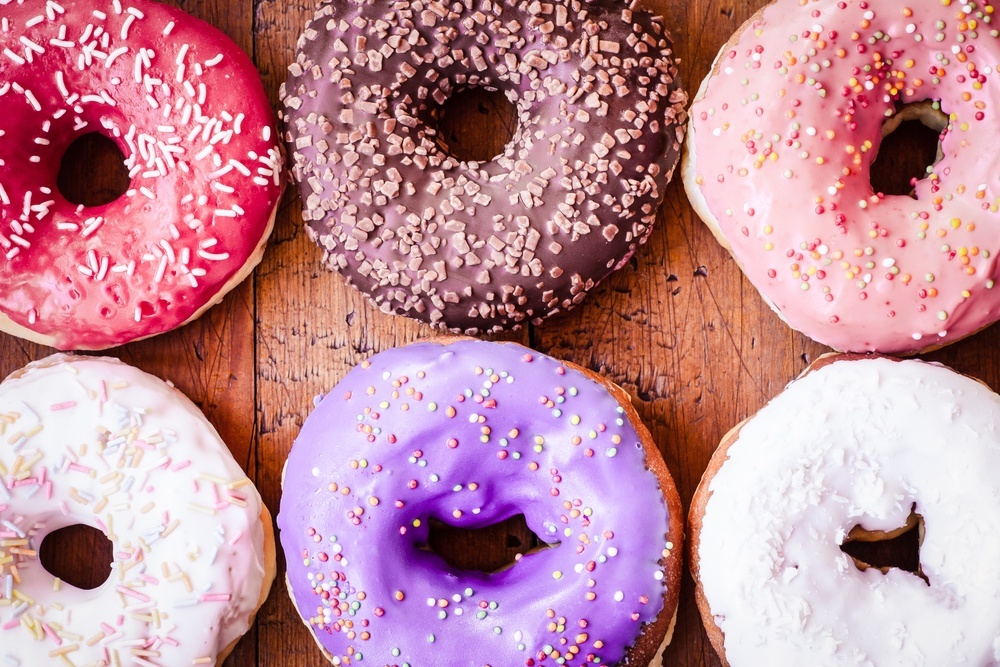In this day and age, with all the unhealthy foods plaguing our grocery stores and diets, it’s hard to figure out how to eat less sugar.
Sugar sneaks into even the most unexpected food items, and is almost as addictive as cocaine, making it extremely difficult to give up. Currently, Americans consume, on average, 60 pounds of sugar a year and 82 grams of added sugar per day. So, when you’re trying to get heart healthy, how do you beat all that sugar? How can you eat less sugar and improve your heart’s health?
We’ve listed key steps you can take to help you eat less sugar and improve both your heart’s health and your overall health.
1) Be Aware of the Sugar Content in the Food You Eat
This means being aware of just how much sugar surrounds you every single day in the foods you consume.
Sugar is so accessible in your office vending machines, in sports drinks, in pre-packaged or frozen meals that are supposed to make your life easier.
In short, sugar is everywhere. Being aware of that is the first step to eating less of it.
2) Think Long Term about Changing you Habits
It’s hard not to reach for soda when you need that caffeine fix RIGHT NOW.
And it doesn’t help that the least expensive grocery store items are the least healthy ones loaded with added sugar.
Think about your long-term health. Think beyond the soda to one, five, ten years down the road. Do you see yourself thriving with a clean bill of health? Good. Because the only way to get there is by making changes right now.
Begin making small changes by cutting out one item at a time. For example, replace dessert once a week with fresh fruit instead. Once you’re comfortable with that change, make another change in the right direction rather than cutting sugar altogether to start.
3) Stick To Fruit to Cut Down on Sugar
Many people who have a lingering sweet-tooth (especially the kind that hits late at night) don’t necessarily want anything specific, they just want SOMETHING that tastes like a dessert or sweet treat.
Thankfully, nature provides us with it’s own sugar that won’t do the same damage in countless kinds of fruit.
Keep strawberries, citrus fruits, and melons in your refrigerator for naturally sweet snacks that don’t taste like they should be healthy (but totally are!). You can include fruit at the end of your meal to help you avoid diving into dessert.
4) Eat Throughout the Day
Eating regularly helps keep your blood sugar levels in check and prevents levels from sinking so low that you will have you craving an entire package of Oreos.
Low blood sugar levels often have you scrambling for fast, easy, and not necessarily healthy snacks packed with sugar.
Healthy fats and protein in dairy, meat, and nuts are more likely to keep you satisfied and blood sugar levels where healthy throughout the day, preventing a sugar binge that causes damage to your cardiovascular health.
RECOMMENDED: Take your heart healthy lifestyle to the next level with L-arginine Plus!
5) Beware of Fat Free
Some fat-free products sound too good to be true because, well, they are.
Often, fat-free desserts and candies do, indeed, contain little or no fat. In exchange for the lack of fat, food makers will add sugar to improve the taste of the product. Look for foods without added sugar rather than choosing fat free products.
6) Say No To a Sugar High to Avoid a Sugar Crash
You’re probably familiar with the infamous “sugar crash” which leaves you feeling tired, cranky and without mental clarity.
Unfortunately, in order to fix the crash, most of us simply continue the cycle and eat more sugar to get out of the crash, even if it is only for a short period of time.
Sugar high and sugar crash can come from consuming sugar in a very concentrated amount that gets metabolized quickly, which is why it’s best to avoid sugary drinks — even fruit juice.
Fruit juice and soda don’t have any other nutrients, such as fiber (found in whole fruit) that helps regulate blood glucose and insulin levels.
Therefore, the energy you get from drinking that sugar is spent quickly, leaving you drained and searching for more sugar to compensate. Avoid binging on high amounts of sugar to make sure you’re able to avoid hitting a sugar crash.
7) Make Your Own Sauces and Dressings
Believe it of not, sugar is found in ketchup, ranch dressing, even your favorite barbecue sauce or store-bought marinades.
While it makes these meal additions very tasty, it also makes them very unhealthy.
Instead of purchasing store-bought sauces and dressings, try making your own dressings, sauces, and marinades, substituting any sugar called for in the recipe for something with a lower glycemic index such as stevia, honey, or even coconut sugar.
This is also the perfect chance to give spicy and savory sauces a try since their flavors are less dependent on sweetness.
8) If You Can’t Cut It Out, Sub Something In
Maybe you just can’t commit to drinking unsweetened coffee or you need some dessert in your life. Our solution? Substitute.
Cutting out processed, white table sugar doesn’t mean you have to cut out sweet things.
There are plenty of natural sugar substitutes that will give you the sweetness you need, with a lower glycemic index to help protect your heart.
Here are a few reliable sugar substitutes:
• Coconut Sugar
• Agave nectar
• Date Sugar
• Honey
• Maple Syrup
While it’s true some of these options also mean you’re adding sugar to your diet, you’re adding less sugar than you typically would. While it’s not the best option, adding a substitute can help you limit and eventually reduce your sugar intake significantly.
If you liked these eating tips to help improve your blood pressure, check out What Is The DASH Diet?

